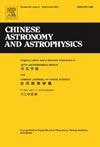Analysis of the Recognition Effect on the Number of Spiral Arms in Spiral Galaxy Images Using ResNet
Q4 Physics and Astronomy
引用次数: 0
Abstract
The spiral arm information contained in spiral galaxy images, especially the number of spiral arms, is of great value for studying the structural evolution and dynamics of galaxies. Against the backdrop of explosive growth in galaxy observation data, how to quickly identify the number of spiral arms has become an important issue in the study of spiral galaxies. The research is based on the Galaxy Zoo DECaLS (Dark Energy Camera Legacy Survey) dataset and studies the ResNet (Residual Networks) model's method of identifying the number of spiral arms from spiral galaxy images. The experimental results show that the accuracy of the ResNet32 model is 83%, which is the best compared to network models such as ViT (Vision Transformer), EfficientNet, and DenseNet. In terms of recognition of different numbers of spiral arms, there is a strong relationship between recognition accuracy and the number of training samples. There are 6800 images with 2 spiral arms, with an F1-Score value of 0.9, while there are only 237 images with 4 spiral arms, with the lowest F1-Score value. The experiment further analyzed the recognition effect of fused traditional galaxy image features and found that the role of fused traditional galaxy image features in improving the recognition of spiral arms is limited.
利用ResNet对螺旋星系图像中旋臂数的识别效果分析
螺旋星系图像中包含的旋臂信息,特别是旋臂的数量,对于研究星系的结构演化和动力学具有重要的价值。在星系观测数据爆炸式增长的背景下,如何快速识别旋臂的数量已成为螺旋星系研究中的一个重要问题。该研究基于星系动物园DECaLS(暗能量相机遗留调查)数据集,并研究了ResNet(残差网络)模型从螺旋星系图像中识别旋臂数量的方法。实验结果表明,与ViT (Vision Transformer)、EfficientNet和DenseNet等网络模型相比,ResNet32模型的准确率达到83%。在识别不同数量的螺旋臂时,识别精度与训练样本的数量有很强的关系。2支旋臂图像6800张,F1-Score值为0.9,4支旋臂图像只有237张,F1-Score值最低。实验进一步分析了融合传统星系图像特征的识别效果,发现融合传统星系图像特征对提高旋臂识别的作用有限。
本文章由计算机程序翻译,如有差异,请以英文原文为准。
求助全文
约1分钟内获得全文
求助全文
来源期刊

Chinese Astronomy and Astrophysics
Physics and Astronomy-Astronomy and Astrophysics
CiteScore
0.70
自引率
0.00%
发文量
20
期刊介绍:
The vigorous growth of astronomical and astrophysical science in China led to an increase in papers on astrophysics which Acta Astronomica Sinica could no longer absorb. Translations of papers from two new journals the Chinese Journal of Space Science and Acta Astrophysica Sinica are added to the translation of Acta Astronomica Sinica to form the new journal Chinese Astronomy and Astrophysics. Chinese Astronomy and Astrophysics brings English translations of notable articles to astronomers and astrophysicists outside China.
 求助内容:
求助内容: 应助结果提醒方式:
应助结果提醒方式:


